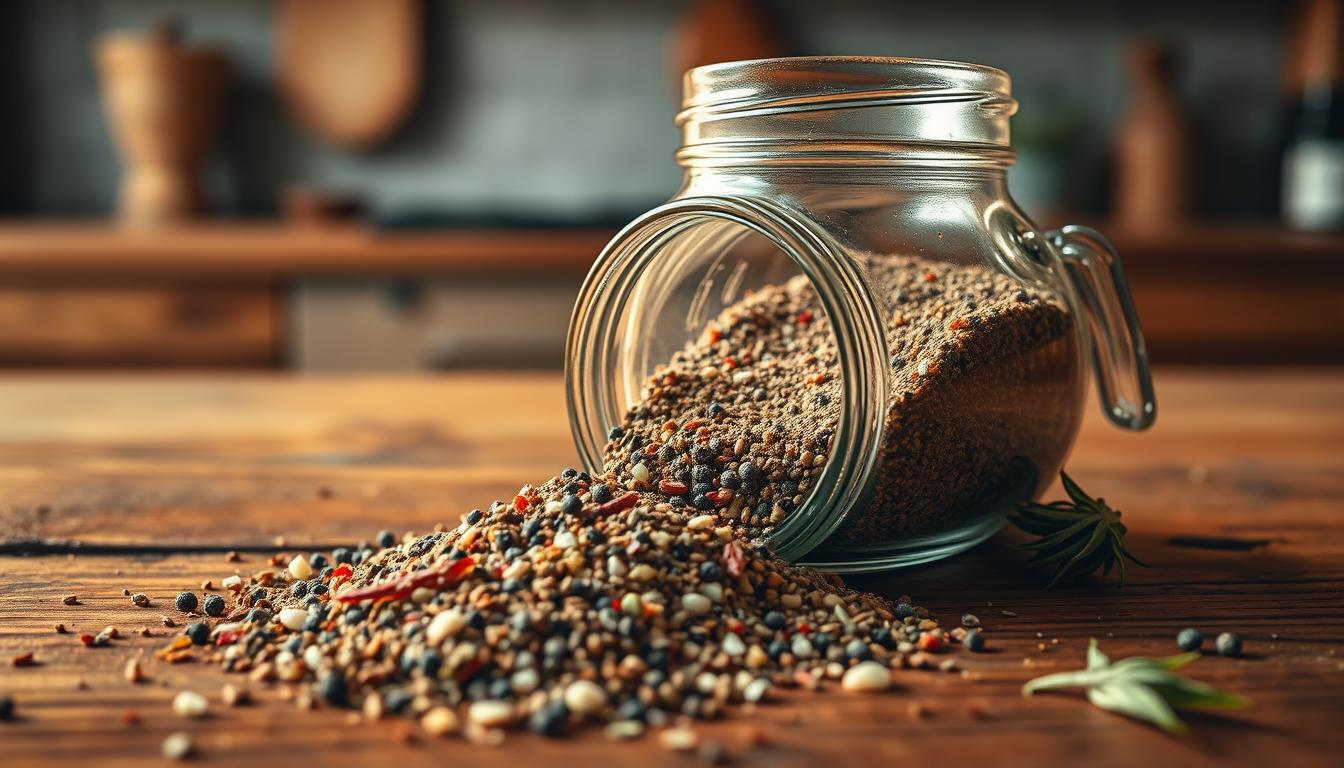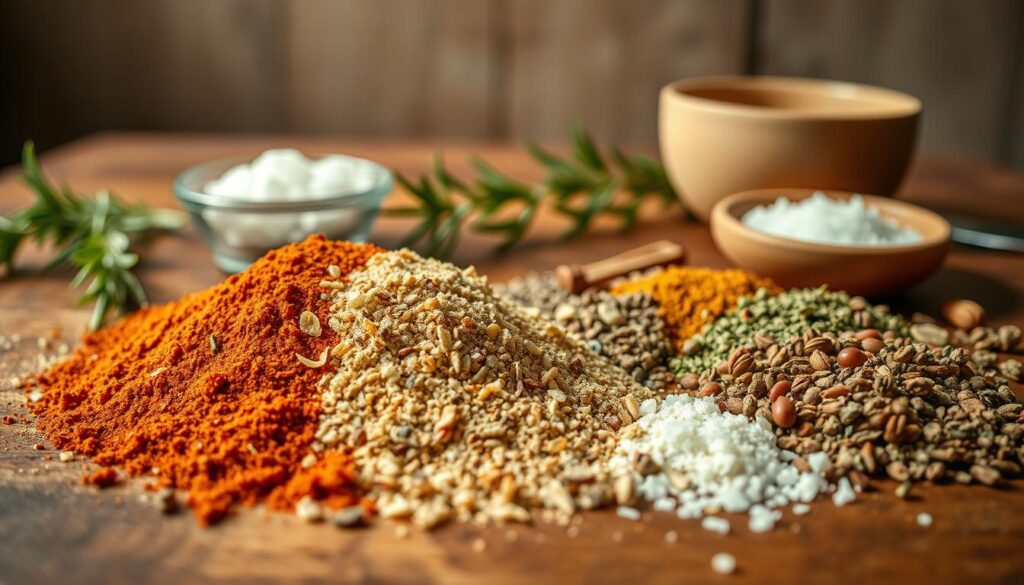How to Make the Best Chicken Seasoning Blend at Home

Are you tired of using the same old store-bought chicken seasoning blends? Making your own blend at home can elevate your cooking to a whole new level. Not only can you customize the flavors to your liking, but you also get to avoid any preservatives or additives found in commercial products.
By creating your own seasoning blend, you have full control over the ingredients and the proportions. This means you can adjust the levels of salt, herbs, and spices to perfectly suit your taste preferences. In this article, we’ll guide you through the simple process of making the best blend at home.
Table of Contents
The Magic of Homemade Spice Blends
Homemade chicken seasoning blends offer a world of flavor and customization that store-bought options can’t match. By creating your own blend, you can avoid preservatives and excessive salt commonly found in commercial seasonings.
Why Store-Bought Seasonings Fall Short
Store-bought chicken seasonings often contain additives that can compromise the natural flavor of your dishes. These may include preservatives to extend shelf life and excessive salt to enhance flavor. By making your own homemade chicken seasoning, you can control exactly what goes into your blend.
| Ingredient | Store-Bought | Homemade |
|---|---|---|
| Preservatives | Often present | None |
| Salt Content | High | Controllable |
| Customization | Limited | High |
Health and Flavor Benefits of DIY Blends
Creating your own best chicken seasoning at home allows you to tailor the blend to your dietary needs and flavor preferences. You can adjust the level of salt, avoid unwanted additives, and incorporate fresh or dried herbs to enhance the flavor. This not only makes your chicken dishes healthier but also more flavorful.
By choosing the right ingredients for your homemade chicken seasoning, you can ensure that your meals are both delicious and aligned with your health goals. Whether you’re looking to reduce sodium intake or simply want to elevate your cooking, homemade blends offer a versatile solution.
Essential Ingredients for Perfect Chicken Seasoning
Understanding the core components of the seasoning is crucial for crafting a blend that enhances flavor. When you know what goes into making a great spice blend for chicken, you can customize it to your taste preferences.
Base Spices Every Blend Needs
Every good cseasoning starts with a foundation of basic spices. These essentials provide the backbone of flavor that other ingredients can then enhance.
Salt and Pepper: The Foundation
Salt and pepper are the cornerstone of most seasoning blends, including those for chicken. They enhance the natural flavors of the chicken and provide a basic depth of flavor.
Garlic and Onion: Aromatic Essentials
Garlic and onion powders are critical for adding an aromatic dimension to your recipe. They contribute a savory flavor that complements chicken well.
Herbs and Spices for Depth of Flavor
Beyond the basics, herbs and spices like paprika, thyme, and oregano add complexity and depth to your seasoning. These ingredients can be adjusted based on personal preference and the type of dish you’re preparing.
As
“The art of seasoning is not just about throwing together a bunch of spices; it’s about creating a harmony of flavors.”
This quote highlights the importance of balancing different ingredients in your spice blend.
Fresh vs. Dried Herbs in Seasonings
When it comes to using herbs in your chicken seasoning, you have the option of using either fresh or dried herbs. Dried herbs are more commonly used in seasoning blends because they have a longer shelf life and a more concentrated flavor.
By understanding the role of each ingredient, you can create a spice blend for chicken that suits your taste and cooking needs.
Basic Chicken Seasoning Recipe
With just a few ingredients, you can make a delicious chicken rub recipe that’s tailored to your taste. Making your own seasoning blend at home allows you to control the flavors and avoid additives found in store-bought mixes.
Ingredients List and Measurements
To start, you’ll need the following ingredients for a basic seasoning blend:
- 2 tablespoons paprika
- 1 tablespoon garlic powder
- 1 tablespoon onion powder
- 1 tablespoon salt
- 1 tablespoon black pepper
- 1 tablespoon dried thyme
- 1 tablespoon dried oregano
These ingredients provide a balanced flavor profile that complements chicken without overpowering it. You can adjust the quantities based on your personal preferences.
Step-by-Step Mixing Instructions
Mixing your chicken seasoning blend is straightforward:
- In a small bowl, combine the paprika, garlic powder, onion powder, salt, black pepper, thyme, and oregano.
- Stir the mixture until it’s well combined and there are no lumps.
- Transfer the blend to an airtight container.
Tip: Use a spoon or small whisk to mix the ingredients thoroughly.
Storage Tips for Maximum Freshness
Proper storage is key to maintaining the flavor and freshness of your homemade chicken seasoning blend.
Container Options
Choose an airtight container, such as a glass jar with a tight-fitting lid, to store your seasoning blend. This will protect it from moisture and other flavors.
Shelf Life Guidelines
Your homemade chicken seasoning blend can last up to 6 months when stored properly in a cool, dark place. If you notice any changes in color, texture, or smell, it’s best to discard the blend and make a fresh batch.
By following these simple steps, you can enjoy a flavorful chicken rub recipe that’s free from additives and tailored to your taste preferences. Experiment with different ingredients to create your perfect blend.
Customizing Your Chicken Seasoning Blend
Now that you’ve mastered the basic chicken seasoning recipe, it’s time to get creative and customize it to your taste. Customization is one of the biggest advantages of making your own organic chicken seasoning at home. You can adjust the blend to suit different cuisines, dietary preferences, or simply to keep your meals interesting.
Adjusting Heat Levels
If you like a bit of heat in your dishes, you can easily adjust the heat level of your chicken seasoning. Adding more cayenne pepper or red pepper flakes can give your seasoning a spicy kick. For those who prefer a milder flavor, reducing or omitting these ingredients can help.
Herb-Forward Variations
For a more herbaceous flavor, you can increase the proportion of herbs like thyme, rosemary, or oregano in your blend. This is particularly great for Mediterranean or Italian-inspired dishes. Experimenting with different herb combinations can lead to unique and delicious variations.
Creating Regional Flavor Profiles
One of the joys of homemade seasoning blends is the ability to create regional flavor profiles. Here are a few examples:
- Mediterranean, Italian, and Middle Eastern dishes often feature herbs like oregano, thyme, and sumac.
- Cajun and Creole cuisines rely on a mix of spices including paprika, garlic powder, and onion powder.
- Asian-inspired seasonings might include ginger, garlic, and sesame seeds.
Mediterranean Blend
To create a Mediterranean-style chicken seasoning, combine oregano, thyme, lemon zest, garlic powder, and a touch of sumac. This blend is perfect for grilled chicken or roasted vegetables.
Cajun-Style Mix
For a Cajun-inspired blend, mix together paprika, garlic powder, onion powder, cayenne pepper, thyme, and oregano. This is great for blackening chicken or seasoning seafood.
Asian-Inspired Seasonings
An Asian-inspired chicken seasoning can be made with ginger, garlic, sesame seeds, soy powder (or salt), and a bit of sugar. This blend works well for stir-fries and grilled chicken.

| Region | Key Ingredients | Best Used For |
|---|---|---|
| Mediterranean | Oregano, Thyme, Lemon Zest, Sumac | Grilled Chicken, Roasted Vegetables |
| Cajun | Paprika, Garlic Powder, Cayenne Pepper, Thyme | Blackened Chicken, Seafood |
| Asian-Inspired | Ginger, Garlic, Sesame Seeds, Soy Powder | Stir-Fries, Grilled Chicken |
Specialized Chicken Seasoning Variations
Transform your meals with unique chicken seasoning blends designed for different tastes and needs. Whether you’re looking for a healthier option, catering to kids, or preferring organic ingredients, there’s a chicken seasoning variation for you.
Low Sodium Chicken Seasoning Options
For those watching their sodium intake, creating a low sodium chicken seasoning is straightforward. You can reduce or omit salt from your recipe and enhance flavor with other spices. Consider using herbs like thyme, rosemary, or oregano, which add depth without adding salt.
To make a low-sodium blend, start with a base of salt-free seasoning mix, then add your choice of herbs and spices. For example, a blend of paprika, garlic powder, and onion powder can add a rich flavor without sodium.
Organic Chicken Seasoning Ingredients
Choosing organic ingredients for your chicken seasoning ensures that your dishes are free from pesticides and other chemicals. Look for organic spices and herbs that are certified by a reputable organization.
Some popular organic ingredients for chicken seasoning include organic garlic powder, organic onion powder, and organic black pepper. You can also experiment with organic herbs like basil and parsley.
Kid-Friendly Chicken Seasoning Blends
For children, a mild flavor is often preferred. You can create a kid-friendly chicken seasoning by using familiar flavors like paprika and mild herbs. Avoiding too much heat or strong spices is key.
A simple kid-friendly blend could include paprika, garlic powder, and a touch of onion powder. You can adjust the proportions to suit your child’s taste preferences.
Here’s a comparison of different chicken seasoning variations:
| Seasoning Type | Key Ingredients | Best For |
|---|---|---|
| Low Sodium | Herbs like thyme, rosemary | Health-conscious individuals |
| Organic | Organic garlic powder, onion powder | Those preferring organic produce |
| Kid-Friendly | Paprika, mild herbs | Children |
Best Cooking Methods for Seasoned Chicken
Now that you’ve crafted your perfect chicken seasoning blend, it’s time to explore the best cooking methods to bring out the flavor in your seasoned chicken. The versatility of homemade chicken seasoning allows you to experiment with various cooking techniques, each bringing out unique aspects of your carefully crafted blend.

Grilling with Chicken Seasoning
Grilling is a fantastic way to cook seasoned chicken, as it adds a smoky flavor that complements the spices in your blend. To achieve the best results, make sure your grill is preheated to the right temperature, and consider using a marinade or rub with your chicken seasoning to enhance flavor and moisture.
Tip: Keep an eye on the chicken’s temperature to avoid overcooking, and use a meat thermometer to ensure it reaches a safe internal temperature.
Baking and Roasting Applications
Baking and roasting are other excellent methods for cooking seasoned chicken. These techniques allow for even cooking and can result in a crispy exterior and juicy interior. When using your chicken seasoning for roasting, consider mixing it with a bit of oil or butter to create a flavorful crust.
“The key to a perfect roast chicken is in the preparation and the patience to let it cook slowly to perfection.” –
Creating the Perfect Rotisserie Chicken at Home
Achieving that perfect rotisserie chicken at home is easier than you think, and it starts with the right seasoning. Using your homemade chicken seasoning blend, you can create a deliciously flavored rotisserie chicken that’s sure to impress.
Equipment Needed
To make rotisserie chicken at home, you’ll need a rotisserie oven or a grill with a rotisserie attachment. Don’t forget skewers or forks to secure the chicken in place.
Timing and Temperature Guide
The key to a perfectly cooked rotisserie chicken is cooking it at the right temperature (usually around 375°F) for the appropriate amount of time, typically about 20 minutes per pound.
Basting Techniques
Basting your chicken with melted butter or oil mixed with additional chicken seasoning during cooking can enhance the flavor and keep the chicken moist. Repeat this process every 20 minutes for the best results.
By mastering these cooking methods and techniques, you’ll be able to enjoy deliciously seasoned chicken that’s sure to become a staple in your culinary repertoire.
Troubleshooting Your Chicken Seasoning
When your homemade chicken seasoning doesn’t quite hit the mark, don’t worry – a few simple adjustments can make all the difference. Whether your blend is too salty, too spicy, or has lost its potency, there are effective solutions to get your seasoning back on track.
Fixing Overly Salty or Spicy Blends
If your homemade chicken seasoning is too salty or spicy, you can balance it out by adjusting the other ingredients. For overly salty blends, try adding more of the non-salty ingredients like herbs or spices. For example, if you have a blend that’s too salty, you can add a bit more paprika or garlic powder to dilute the saltiness.
To fix overly spicy blends, you can add ingredients that counteract the heat, such as a sweet element like sugar or honey, or dairy products like milk or yogurt when you’re using the seasoning in a recipe.
| Issue | Solution |
|---|---|
| Too Salty | Add more herbs or spices, like paprika or garlic powder |
| Too Spicy | Add a sweet element like sugar or honey, or dairy products |
Reviving Stale Seasonings
If your homemade chicken seasoning has become stale, there are ways to revive it. First, check the expiration dates of the individual ingredients. If they’re still within their shelf life, try mixing the blend with a few fresh ingredients to rejuvenate it.
Another method is to toast the spices gently in a dry pan to release their oils and enhance their flavors. This can be particularly effective for blends containing whole spices.
Advanced Chicken Seasoning Techniques
Mastering chicken seasoning involves more than just mixing spices; it requires technique and finesse. To elevate your dishes, you need to understand the advanced methods that can transform a simple blend into a culinary masterpiece.
One of the key advanced techniques is creating wet rubs and marinades. Unlike dry rubs, wet rubs incorporate ingredients like olive oil, yogurt, or buttermilk to create a paste that adheres to the chicken, ensuring it’s evenly coated and packed with flavor.
Creating Wet Rubs and Marinades
To make a wet rub, you can combine your chicken seasoning blend with a liquid ingredient of your choice. For example, mixing your spice blend with olive oil and lemon juice creates a marinade that’s both flavorful and aromatic. The acidity in the lemon juice helps to tenderize the chicken, making it perfect for grilling or roasting.
Toasting Spices for Enhanced Flavor
Toasting spices is another technique that can significantly enhance the flavor of your chicken seasoning. By gently heating spices in a pan, you can release their essential oils, intensifying their flavor and aroma. This simple step can make a noticeable difference in the overall taste of your dishes.
Grinding Your Own Spices
Grinding your own spices is a game-changer for any home cook. Pre-ground spices can sit on a shelf for months, losing their potency. By grinding your spices fresh, you ensure that your chicken seasoning blend is always at its most flavorful. Use a spice grinder or mortar and pestle to grind whole spices into the perfect blend for your recipes.
By incorporating these advanced techniques into your cooking routine, you can create spice blends for chicken that are not only delicious but also sophisticated. Whether you’re making a simple weeknight dinner or a special occasion meal, these methods will help you achieve consistently great results.
Conclusion
Now that you’ve learned how to make the best chicken seasoning blend at home, it’s time to get creative in the kitchen. With a custom blend, you can add depth and complexity to your dishes, from grilled chicken to roasted vegetables. Experiment with different recipes and techniques to find your perfect flavor.
By making your own chicken seasoning, you can avoid preservatives and additives found in store-bought blends. You can also tailor the flavor to your family’s taste preferences, whether that’s spicy, smoky, or herb-forward. The versatility of homemade chicken seasoning makes it a valuable addition to any kitchen.
Try adjusting the heat levels, experimenting with new herbs, or creating regional flavor profiles to keep your cooking fresh and exciting. With your homemade chicken seasoning blend, the possibilities are endless, and you can enjoy delicious, flavorful meals every time.
